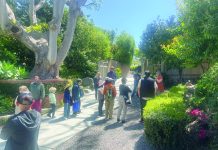Help Protect Your Family’s Health
 During wildland fires — including recent record-breaking events — billowing columns of smoke spread harmful levels of air pollution across wide areas of the Southland. Particulate matter, or small particles suspended in the air, is one of the main components of smoke. High levels of particulate matter from wildfires can cause throat and eye irritation, aggravate asthma and trigger other respiratory conditions. Breathing high levels of particulate matter over long periods of time can also cause more serious health problems.
During wildland fires — including recent record-breaking events — billowing columns of smoke spread harmful levels of air pollution across wide areas of the Southland. Particulate matter, or small particles suspended in the air, is one of the main components of smoke. High levels of particulate matter from wildfires can cause throat and eye irritation, aggravate asthma and trigger other respiratory conditions. Breathing high levels of particulate matter over long periods of time can also cause more serious health problems.
Smoke from burning wood in home fireplaces contains the same primary pollutants as smoke from wildfires. Although some might consider residential wood smoke as “natural,” smoke caused by burning wood in fireplaces can emit more than five tons of fine particulate matter (PM2.5) per day in the South Coast Air Basin. That is more than three times the amount of PM2.5 emitted from all of the power plants in the Southland.
To reduce hazards caused by residential wood smoke, the South Coast Air Quality Management District created the Check Before You Burn campaign. As part of this effort, “no-burn” alerts are issued by SCAQMD when stagnant weather conditions are forecast to elevate fine particulate pollution to unhealthy levels. On no-burn days, wood burning in fireplaces, backyard fire pits and wood stoves is prohibited in the four-county region (Orange County and the non-desert portions of Los Angeles, San Bernardino, and Riverside counties). The Check Before You Burn season begins every year on Nov. 1 and ends the last day of February.
This winter, unusually persistent, stagnant conditions have resulted in more than 30 no-burn days – more than any previous year since no-burn alerts were first issued in 2012. Help do your part to protect your family’s and community’s health by not burning on no-burn days. Check Before You Burn by visiting www.airalerts.org.
Wayne Nastri is the executive officer for the South Coast Air Quality Management District.





Thank you for your message comparing wildfire smoke to everyday residential wood burning. Most people realize wildfire smoke is toxic, while many don’t believe that small residential fires – from fireplaces, fire pits or wood burning restaurants – can add up to harm. I live in Santa Barbara. We just got the lesson of our lives about wood smoke.
Just as there is no safe level of tobacco smoke, according to the US Surgeon General, there is no safe level of wood smoke, because they all contain a host of the same deadly toxins that are bundled with the carbon soot. It is also a myth that you can “burn clean” and minimize harm to others. Residential, recreational burning, including beach bonfires, are a terrific source of public health issues. Wood smoke can send anyone to the ER or the morgue, and it is increasingly contributing to asthma and absenteeism in our nation’s schools. Please don’t burn wood at any time–there are cleaner, safer alternatives.